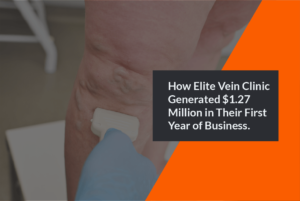As the business owner or office manager of a medical clinic, what do you believe are the most important numbers you should know to determine the health of your company?
Gross revenue? Gross profit? Net profit?
Although all those numbers are important, you will soon realize they are arguably not the most important if your goal is to earn more “net profit” and develop a “business asset” that can be sold in the future.
Hello everyone! My name is Todd VanDuzer and I am the CEO & co-founder of three multi-million dollar businesses: Elite Vein Clinic, a vein clinic; Natural Med Doc, a naturopathic and functional medicine practice; and founder of Duzer Group: a digital marketing agency. We have helped dozens of clients add an additional 1+ million dollars in revenue to their businesses per year.
“If you can’t measure it, you can’t improve it” – Peter Drucker
To guarantee a company’s success, there are several key numbers that should be tracked and all leadership roles (operational, marketing/sales, and financial) should have strong KPIs – key performance indicators that are both:
- Qualitative, meaning non-numerical data, and
- Quantitative, meaning numerical data.
These measure the performance of their role.
This ensures if a member of the team leaves, you will know exactly who to hire for and what quantifies success.
It will also allow your company to scale without you. This is how my wife and I were able to leave on a 3-month honeymoon all while three of our businesses had a record quarter.
However, this process is an entire video series for another day.
Today, I want to discuss the 4 most important numbers we look at regularly inside our business and tell you why you should track these too.
4 Most Important Numbers in Your Business
1) LTV – Lifetime value of the customer or patient who reached the desired outcome
2) Consult > Desired Outcome – Conversion rate
3) Cost Per Consult Per advertising channel
4) Yearover-year growth of the business profit AND year over year growth of the business revenue – I realize these are technically two numbers but I will explain why they should be considered as one as you read on.
1) LTV: Lifetime value of the customer or patient who reached your desired outcome
As a medical clinic, you are in the business of both seeing patients and also helping them solve health concerns.
Typically, your business will have 1 – 3 core offerings (primary services you offer), but even if you have more than that, this still applies.
No matter the number of offerings, you should have a clear goal and understanding of your desired outcome of said core offering(s).
For example, as a med spa, it might be: “Botox, PRP, or another treatment.” Other examples include PRP therapy for a pain doctor, or ablation treatments for a vein clinic, or hormone membership for a hormone clinic.
Many times for clinics, this desired outcome is a “procedure”.
Once a clinic reaches that desired outcome, you should calculate the average business generated from these patients over the next three months, six months, and twelve months.
This is the lifetime value of your customer or patient over that period of time.
In the following example, we will focus on LTV over a 12-month period.
To take it a step further, you can subtract your variable expense (expenses directly tied to the patient).
This typically includes COGS (cost of goods sold) or medical supplies directly tied to serving the patient…
AND
…employee or contractor time serving the patient.
In some cases, this employee or contractor is on salary. If this is the case you may not want to view this as a variable expense since you’ll be paying them regardless.
For example, let’s say you determine that the average patient who reaches your desired outcome – let’s call it “procedure” in this instance – ends up generating the clinic $5,000 over the course of the next 12 months.
You then calculate and find that $1,000 goes towards COGS & medical supplies in performing those procedures.
Your staff is paid based on RVUs, or output, and that costs you $2,000.
Therefore, you have $2,000 LTV after variable expenses.
By knowing this number, you now know the worth of each patient.
Then you can work backwards in understanding how much you are willing to spend to acquire them and ensure your ROI is greater than what you would get in any other type of investment!
2) Consult > Desired Outcome: Conversion rate
The 2nd number you want to understand is your consult to desired outcome conversion rate.
Typically, a patient’s first step in the process is the consult.
Every clinic is different – this first in-person or online interaction may be called something else in your office – but for the sake of this article, we’ll refer to it as a “consult.”
Your goal – as long as it makes sense ethically and you can serve the patient – is to get them to that desired outcome that we defined in the previous step.
This step is tracking just that.
How many consults do you have every month? And how many of those result in the desired outcome?
Now be careful: there are two forms of data you should be looking at, and many people often track the wrong numbers, getting incorrect results.
And inaccurate data = bad business decisions.
These are the two types of data:
Apples to Apples data is tracking every consult that comes in one month – let’s say January– and then tracking at what point those consults turn into “desired outcome”.
Week by Week data is tracking how many consults came in January and then how many desired outcomes came in in January.
As you might see, if you take the number of desired outcomes that came in January and divide it by the number of consults that came in January, you are not going to get the right percentage.
Why?
Because many of those desired outcomes are likely attributed to November or even December.
To get an accurate conversion, you need to ensure you are tracking apples to apples. Track all patients from January and follow them along their journey.
10 patients came in January and by April 7 converted to the desired outcome.
Then your conversion rate for January was 70%.
Once you know your LTV after variable expense AND your conversion rate, you are ready to start investing in different advertising channels!
3) Cost Per Consult
You now know the lifetime value of your patient over a 12-month period MINUS variable expenses (expenses that otherwise would not exist if you had not seen the patient).
You also know what your conversion rate is from consult to the desired outcome. You’ve looked at your apples-to-apples data to get the accurate number.
Therefore, if your conversion rate is 70% and your lifetime value is $2,000…
How much are you willing to “spend per consult”?
Assuming you are already a business that is operational and making a profit, you can spend up to 70% of that $2,000, or $1,400 to acquire your customer and still break even.
However, we are not in business to break even. We are in business to make a profit!
So in this example, what are you willing to “spend per consult”?
$500? $1,000? $1,400?
To calculate this, we have many more questions we need to ask.
How much bandwidth does your team have? How much extra space do you have in your office? At what point will you need to increase your fixed expenses? Are you already profitable? Are you trying to grow to sell?
And without knowing your business, it is difficult to provide you with an exact number. There is some general guidance however:
If your business has high fixed expenses, you will want a lower cost per acquisition in relation to your LTV after variable expenses.
If your business has high variable expenses with low fixed expenses, you should be willing to have a higher cost per acquisition in relation to your LTV after variable expenses.
If your business only has variable expenses, you should theoretically be willing to spend very close to the maximum amount as long as your return on investment comes out to greater than 15% (return on riskier investments).
Based on the example in this post example, I would be comfortable with anything around $700 or less.
If I’ve spent $700 in this example, I would be making $700.
That is 100% return on my investment– not bad!
Now that you’re figured out:
- Your 12-month LTV after variable expenses,
- Your conversion rate of consult > desired outcome, and
- What you are willing to spend per consult,
You are ready to start investing money into different marketing channels, so that patients will find you. But this, once again, is another video for another day!
Just be aware that knowing these numbers, you can start spending money on platforms like Google, Facebook, TikTok, direct mail, etc.
…and as long as you can track your “cost per consult” and keep it under your desired threshold, you know you are making a profit and generating a bigger return than any other investment vehicle!
Pretty cool, right?
This is exactly how I have personally built multiple multi-million dollar medical clinics and have helped dozens of our clients do the same.
And the best part? There is a ton of sophisticated tracking software out there that allows you to do just that.
We are personally big fans of CallRail, Google Analytics, Tag Manager, and Zapier, and have also built sophisticated custom Google sheets integrations with a full-time person monitoring every single lead to ensure it has an attribution.
Is it a lot of work? Yes! But accurate data matters. You can’t make profitable decisions with inaccurate data, and our mission is to help our clients scale profitably.
Now, let’s now get to that last number that every medical clinic should track.
4) Year-over-year growth of the business profit and year-over-year growth of the business revenue
Say a business generated 1 million dollars in revenue in year 1 with 10% profitability or $100,000.
Then the next year, this business is generating 2 million dollars in revenue with 8% or $160,000.
If you were just looking at profit, this business looks to be doing pretty well right?
Sure – things are going well. They’ve had a 60% increase in profit.
However, there are inefficiencies in this business. Why?
If a business doubles in revenue but profits don’t at least double in revenue, there are some inefficiencies.
In fact, due to economies of scale (remember that one econ class from college?),their profit should actually increase.
Therefore, if they did 2 million dollars in revenue the following year, anything less than 10% profit is a red flag.
Now there is always a reason why this may be ok – but it is something to keep an eye out for.
Recap:
As a quick recap, let’s review the 4 most important numbers of a medical clinic:
1) LTV – (Lifetime value of the customer or patient who reached the desired outcome)
2) Consult > Desired Outcome – Conversion rate
3) Cost Per Consult (Per advertising channel)
4) Year-over-year growth of the business profit & year-over-year growth of the business revenue.
By having those 4 numbers dialed in, you will set up your clinic to:
- Ethically help more patients
- Generate more revenue
- Generate more profit and
- Develop an asset that can be sold!
If you have questions on these 4 metrics or are interested in learning more about Duzer Group’s digital marketing agency, visit our website and book a free no-cost consultation today!



